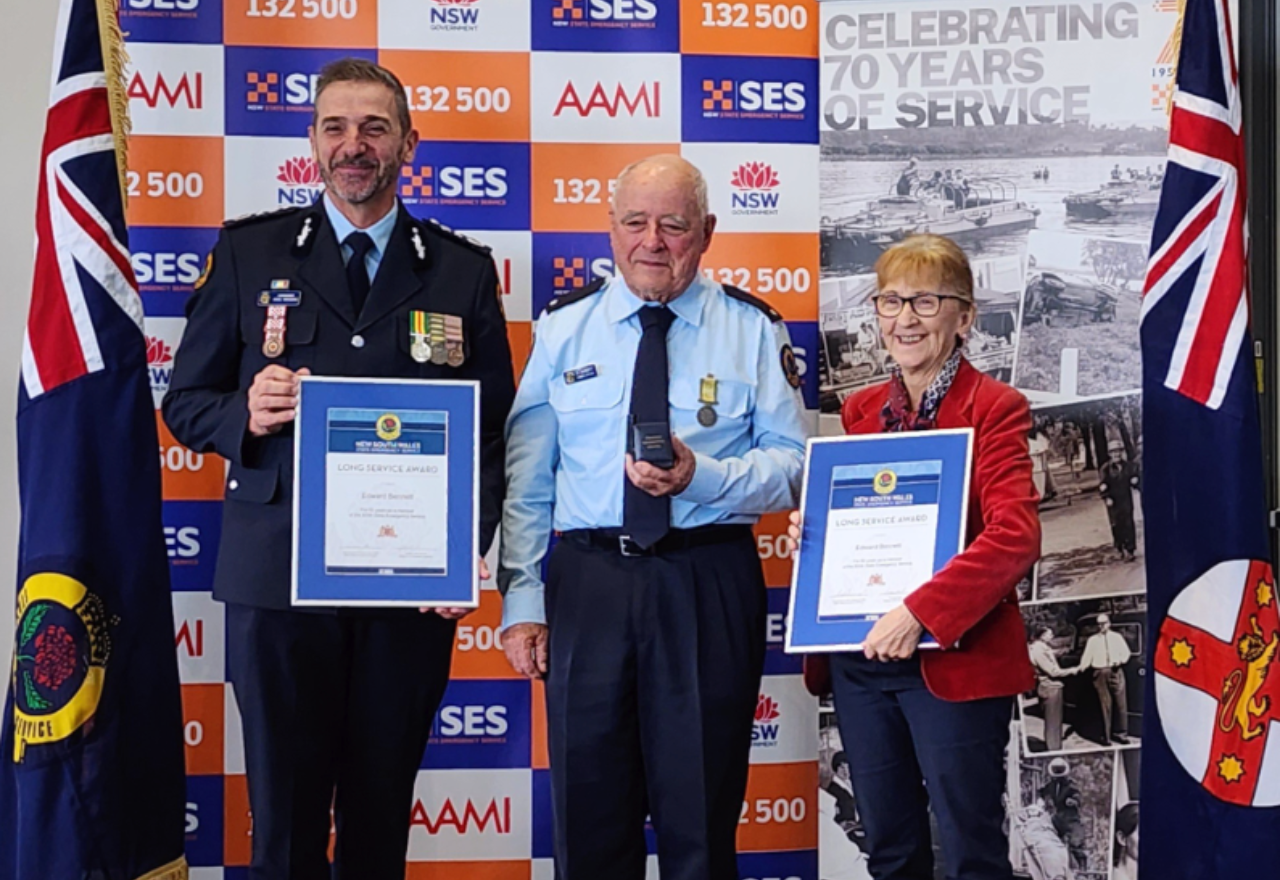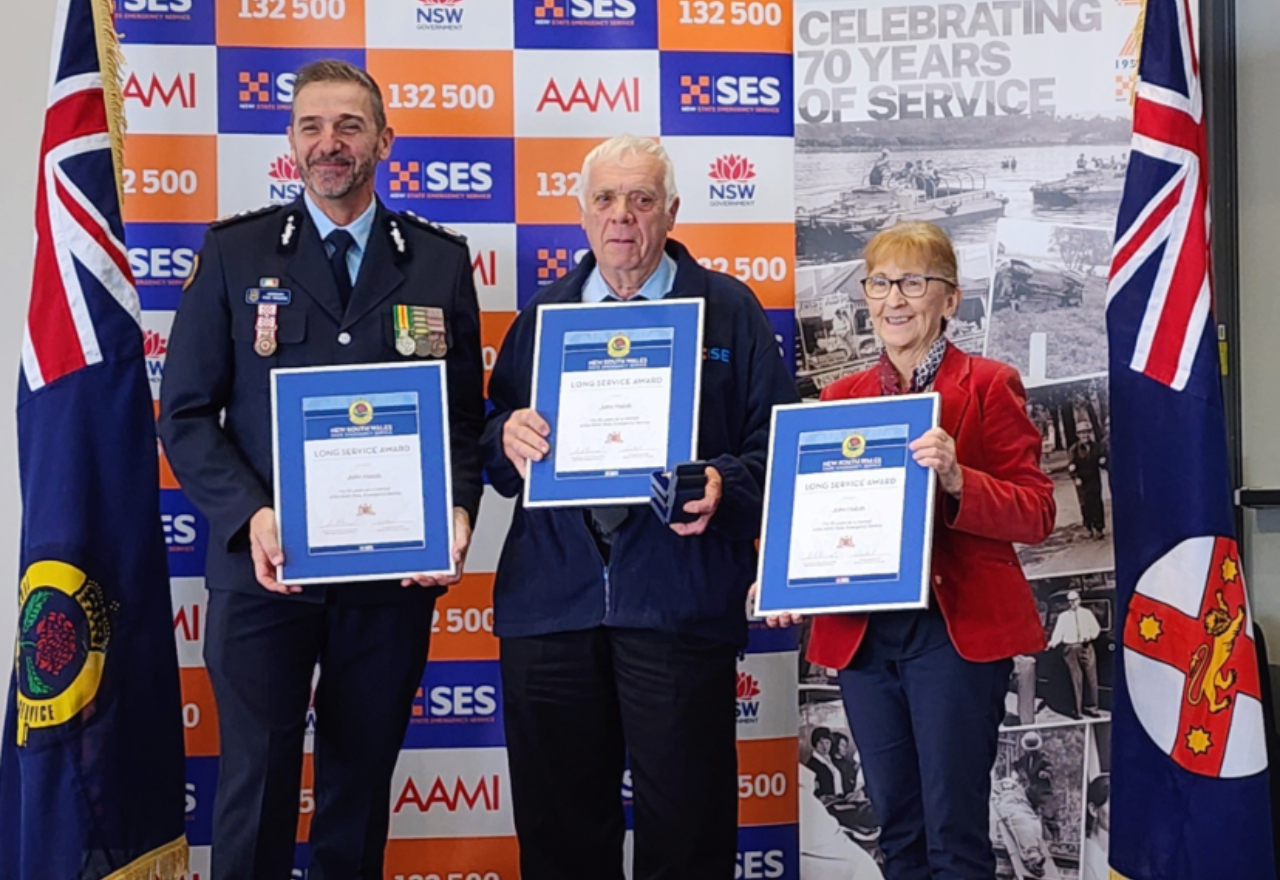Ed Bennett and John Habib celebrate 60 years volunteering at SES
Simon Mumford
23 June 2025, 9:01 PM
 Ed Bennett receiving his 60 Years of Service Award at Ballina on the weekend. Photo: NSW SES Lismore Unit
Ed Bennett receiving his 60 Years of Service Award at Ballina on the weekend. Photo: NSW SES Lismore UnitAt a special NSW SES North Eastern Zone Award Ceremony on Saturday in Ballina, two Lismore stalwarts were awarded their fourth clasp and a certificate for 60 years of service.
It is difficult to imagine that a person can volunteer for such a long period of time. Such a commitment to helping the community certainly deserves public recognition.
Stand up Ed Bennett and Jon Habib. Each 15 years, volunteers receive a clasp to put on their ribbon. Ed and John now have four each.
Ed Bennett also received the National Emergency Medal for the 2017 Cyclone Debbie event.
Ed started his service in February 1964, at the age of 23, when he moved back to the Northern Rivers after six years away teaching.
"I joined what was then called the Civil Defence, which morphed into the SES a few years later," Ed explained.
"I got transferred to Richmond River High School, but just before my transfer went through, I received a letter from my immediate boss at Richmond River and amongst other things, he said, as a fit young male, you'll be expected to do four things. One was playing in the cricket team that was made up mostly of Richmond River staff because that year the Southern District Cricket Club formed, and one of our staff members said we've got enough people here to provide you with a team. So, I was expected to join the cricket group and play golf because a lot of young males were playing golf.
"And I'd be expected to join the flood group with the Civil Defence because it was run by one of the staff at Richmond River. And the fourth thing I was expected to do was give the lizard a run at the Metropole on a Friday afternoon. I didn't quite know what that meant, but I found out it was going and having a beer with the boys at the end of the week."
"So, as soon as I got here, the very next week after school started in early February 1964, I was out on the river in a boat learning the ropes".
Ed explained that he stayed in the flood group from 1964 to 1975, when he was moved to the flood intelligence group, which was attached to the Richmond Tweed Region, now called the North Eastern Zone at Lancaster Drive, Goonellabah. Then, in 2016, he moved to the Lismore City Group.
As you can imagine, Ed has seen and experienced many floods in his 85 years. What has been a significant improvement in that time?
"Just to give you an idea of how things have changed, in the '60s we had little tinnies, as you describe them, with 10 and 15 hp motors. In one of the floods, either '65 or '67, a good mate and I were put up in a house near Riverview Park and we had to putter around South Lismore doing various things but if we wanted to get back to the to the rowing club building which is near the Transit Centre, our motors weren't strong enough to go straight up the river against the current. We had to creep up the western bank and then go a little bit upstream and then come across at an angle to the rowing club.
"Of course, now, the boats are bigger and they've got 60 hp and even 90 hp motors. Those sorts of things change in every aspect of life. If you go back a little bit further in the 1954 flood, which was the same height as the '74 flood, the local group wasn't called Civil Defence, it was called the Lismore Water Brigade and Rowing Club, and they had rowboats. They didn't have motors then."
Ed's 60-Year Long Service recipient is his good mate John Habib. John's father was on Lismore City Council and had a lot to do with the development of the Lismore Airport, and also volunteered with the NSW SES. Everyone knows of Habib Drive in South Lismore.
"John is the flood warden for South Lismore," Ed explained, "He goes around talking to businesses and residents, especially as a flood is developing and approaching. He'll go and give people some early warning. John is well-liked and well-respected, and he's been doing that for a long time, while his father had the same position before John.

(John Habib receiving his certificate and clasp for 60 years of service to the NSW SES)
The NSW SES is always looking for volunteers, and Ed took the opportunity to list an array of jobs that people can do within the SES.
"We have specific boat crews. We have other people who specialise in getting up on the roof and putting tarpolins on and doing temporary repairs. Other people are qualified chainsaw operators who go out and cut up trees that fall over a driveway so people can have access. And then there are people who have indoor jobs.
"There are people who operate our phones and computers and deal with calls for help, and pass them on to the people who can actually go out and do the outdoor tasks. Also, the SES volunteers are called upon to help the police from time to time with searching for people and helping out at road accidents, all sorts of things. It's quite a range of things that people do. Everybody's welcome," Ed said.
At the age of 85, Ed is starting to think about allowing the younger members to come through.
"How long is a bit of string? I've just had my 85th birthday, so I thought that might be a good time to think about retiring. There's a couple of things in the pipeline later this year, so I'll probably give it away at the end of this year."
As you can imagine, Ed has a wealth of experience when dealing with all aspects of a flood. Ed wanted to impart what happens at the NSW SES North Eastern Zone headquarters in Goonellabah.
"When a rain event comes that might lead to flooding, we keep an eye on the rainfall over the catchment, and we've got automatic flood gauges on all the major streams, and we monitor those. We have contact with the Bureau of Meteorology, and over the years we've had a lot of conversations with them where, on occasion, we've disagreed with their prediction and had a discussion, and sometimes they've sort of modified their prediction.
"It's a good relationship we have with them. One interesting thing, a good mate of mine, Trevor Reynolds, who was a teacher at Lismore High and a mathematician and computer whiz, developed a flood forecasting model, which the bureau has taken aspects of it and incorporated into their forecasting."
"I think the BoM gets a fair bit of unfair criticism, because I mean they're not perfect and they'll admit that, and a lot of people don't fully understand that a forecast is what they think is likely to happen and when they forecast rain or whatever and it doesn't eventuate exactly as their forecast people will say they got it wrong again. And of course, they're going to get it wrong again because forecasting things is not an exact science. It's not like an experiment that you conduct in a laboratory.
"I read a comment that somebody made from Melbourne. They said we will never be able to forecast that. I'll put it in a local context. A thunderstorm is going to hit Lismore airport at 3 pm tomorrow afternoon and bring 35mm of rain, that sort of accuracy just is not possible."

